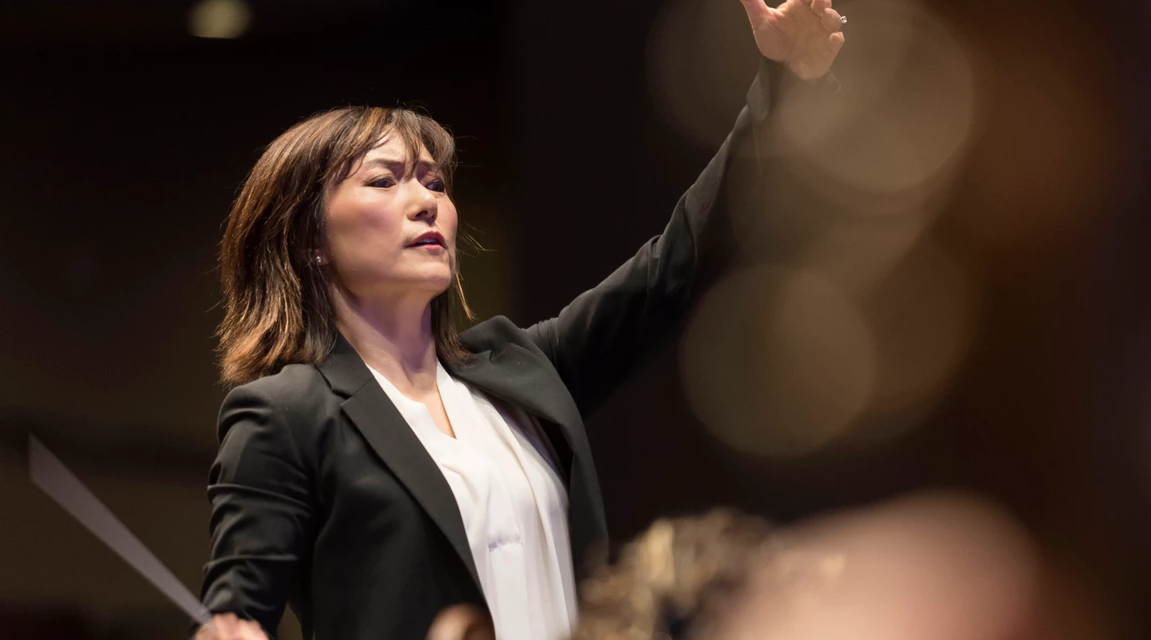Conductor Rei Hotada. Photo: Paul Mullins
Pines of Rome
Louisville Orchestra
Rei Hotoda, conductor
A review by Annette Skaggs
Entire contents are copyright © 2022 by Annette Skaggs. All rights reserved.
Attending orchestral performances are always a treat, but I am particularly delighted when I am introduced to new music. Such was the case for Saturday’s Louisville Orchestra concert featuring Ottorino Respighi’s Fountains of Rome and Pines of Rome.
The evening began with Lili Boulanger’s D’un matin de printemps (Of a Spring Morning). If you are familiar with the Boulanger name, chances are you are familiar with her famous sister Nadia, who worked with notables such as Aaron Copeland and Elliott Carter. Despite her untimely death at the age of 24, Lili was rather accomplished. For example, she was the first woman to win the Prix de Rome in 1913 for composition. It has only been fairly recently that Lili’s works have been resurrected and what a refreshing addition to the canon. Printemps is a musical picture of nature waking up and a study in orchestration. While at times the whole of sound is a bit busy, every note and instrument has a nuanced role to play, such as an unusual occurrence in the strings where not every instrumentalist is in synch with the other and the barely noticeable playing of a cymbal or top hat that emulates the rolling of thunder in the distance. Truly a lovely start to the concert.
If you are like me, I never considered Beethoven a fun, comical and lighthearted composer. But that perception changed a little as I listened to his Symphony No. 8 in F Major, Op. 93. While being familiar with this shorter than usual symphonic work, our guest conductor Rei Hotoda shared some interesting tidbits about the piece and its creator that prompted me to listen a bit more closely.
While this symphony is written with the common four movement outline, the movements chosen are a departure from the norm. For example, the second movement is commonly written in a slower tempo, not so here: Allegretto scherzando is actually rather quick. Another exit from tradition is found in the third movement where Beethoven returns to compositions of old that used dance themes, thus giving us Tempo di menuetto, with its warm and frothy bassoon line. The first and fourth movements fit the standard formula pretty closely, but I found that the mimicking between the instruments to be quite tantalizing.
Theories abound as to why Beethoven approached the 8th this way, many of which center on the unusually brief time he took; Symphony No. 8 was written within a few months. Perhaps he was challenged by a peer, maybe he was in especially good humor, or it very well could be that the music wrote it self in his mind. What we do know is that within the mastery of Beethoven’s composition that he was able to utilize instrumentation that would often mimic the sounds of both nature and man. What is also talked about is that this symphony has humor, as Ms. Hotoda shared earlier. Humorous? In fact, she’s right. She imparted something to listen for in the second movement: the winds mimic a tool that is commonly a musician’s nightmare: the metronome.
I am familiar with Respighi’s tone poem Fountains of Rome, but less so with the whole of his Pines of Rome, having heard only movements of the work. These two pieces are among the composer’s best-known and most often played pieces. Upon listening to both in their entirety, I can certainly understand why.
It is a magical score that brings the stories of the fountains and flora of Italy, specifically Rome, to life, transporting the listener on a personal journey.
Fountains of Rome concentrates on the artist’s memories of the beauty and surroundings of four stunning fountains and serves as the orchestration’s movements: Valle Guilia all’alba, Tritone al mattino, Trevi al meriggo and Villa Medici al tramonto.
Immediately, one is transported to town squares where the hustle and bustle of life and the sound of gurgling water from the historic aqua monuments are written within. But what makes these soundscapes even more beautiful is that Respighi focuses his music upon reflections of these fountains for different times of day: Valle Guilia at dawn, Triton in the morning, Trevi at midday, and Villa Medici at sunset. Each of these times of the day offers different sounds and images that the composer brought to life. For example, a gorgeous melody from Nicholas Finch on cello made me think of the sun gently rising over the cascading water of the Valle Guilia. Conversely, in the fourth movement, the sound of church bells ring throughout the hall, signaling the end of the day as the notes bounce off the pool of water at the base of the Villa Medici. Throughout the movements, the sound of water could be heard in cascading runs on the strings of two harps and a keyboard. Just lovely.
When introducing the “Rome” poems, Ms. Hotoda commended our Louisville Orchestra for being brave enough to perform the pieces, as they are intricate, delicate, and require an expert’s touch. Also, the works require a full orchestra and, like many other organizations around the world, the pandemic has caused shortages from time to time from within the ranks. But, as luck would have it, we had the talent ready and willing to go!
Just as the composer perfectly captured life around the fountains, his Pines of Rome, concentrates on the flora and fauna around him, beginning with the first movement set at the Villa Borghese, a palace with lush gardens and large, extending grounds and parks. These Pines are full of life and imbued with the music of the time and era, folk songs, and nursery rhymes, as historians have shared. It isn’t hard to think about couples walking hand in hand as children play and frolic within the flowers.
As the title might imply, the second movement, Pines Near a Catacomb, is a bit starker and more somber. Using these burial sites as his inspiration, Respighi creates an homage to all of those who have been consecrated within the catacombs. One of the most effective measures of this movement was from the sound of an offstage trumpeter, playing a mournful prayer of sadness and consolation. Truly effective and moving.
Contained within The Pines of the Janiculum, the third movement, we are climbing a hill. The Janiculum is one of a series of hills that surround Rome and Respighi takes us on the trek with a delightful piano and clarinet introduction that gets our hearts and minds ready for the journey. As we continue, we can hear the birds overhead, nestled in the pines. I was a little disappointed that we heard recorded birds instead of using the winds to mimic birdsong.
To finish off strong, the fourth movement brings a triumphant march in The Pines of the Appian Way. If you know your history, you are aware that the Appian Way was the road that connected Rome to the East and served as a main artery of commerce and, unfortunately, war. Knowing its importance to the Roman way of life, Respighi created a rousing and triumphant close to his Pines, using the brass section to herald many successes and give flourish to the symphonic masterpiece.
Bravi Tutti!
Pines of Rome
January 29, 2022
Louisville Orchestra
Kentucky Performing Arts
501 West Main Street
Louisville, KY 40202
Louisvilleorchestra.org
Annette Skaggs is heavily involved as an Arts Advocate here in Louisville. She is a freelance professional opera singer who has performed throughout Europe and in St. Louis, Cincinnati, Boulder, Little Rock, Peoria, Chicago, New York and of course Louisville. Aside from her singing career, she has been a production assistant for Kentucky Opera, New York City Opera, and Northwestern University. Her knowledge and expertise have developed over the course of 25+ years’ experience in the classical arts.





